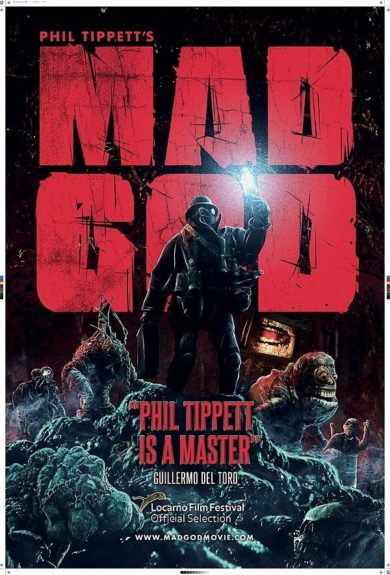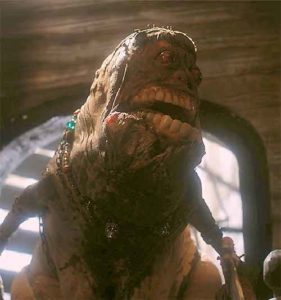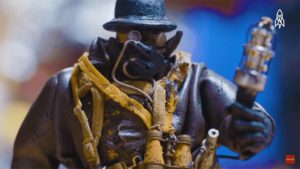 An example of a long-in-the-works film finally coming to fruition in 2022 (THE PRIMEVALS being another), MAD GOD is a dialogue-free depiction of an otherworldly hellscape, peopled almost entirely with stop motion creatures.
An example of a long-in-the-works film finally coming to fruition in 2022 (THE PRIMEVALS being another), MAD GOD is a dialogue-free depiction of an otherworldly hellscape, peopled almost entirely with stop motion creatures.
MAD GOD is a dialogue-free depiction of an otherworldly hellscape, peopled almost entirely with stop motion creatures.
The project was initiated in 1987 by the Hollywood special effects maestro Phil Tippett (whose credits include the original STAR WARS trilogy, ROBOCOP and JURASSIC PARK), who with help from student volunteers labored on it over the following three decades. During that time he released a trio of MAD GOD shorts (comprising roughly half the finished film) online that helped bequeath the legendary status the film holds among cultists.
Tippett can’t be blamed for the fact that while this epic was in production a gaggle of similarly oriented stop motion fueled features, such as THE SECRET ADVENTURES OF TOM THUMB, BLOOD TEA AND RED STRING, MECANIX and JUNK HEAD, proliferated (meaning a Fangoria contributor’s claim that Tippett’s film has “no cinematic comparison” is inaccurate). Yet MAD GOD outdoes them all in scope, ambition and sheer skill, having been made by a veteran special effects genius whose dedication is evident from start to grungy finish.
MAD GOD outdoes them all in scope, ambition and sheer skill, having been made by a veteran special effects genius whose dedication is evident from start to grungy finish.
MAD GOD begins with several macabre quotes taken from the Book of Leviticus (“You shall eat the flesh of your sons, and the flesh of your daughters…I will make the land desolate, and your enemies who settle in it will be appalled at it”), which set the tone quite adequately for a film that takes place in a nightmarish landscape of perpetual warfare. Amid this chaos a gasmask wearing individual known as the Assassin lowers himself into the underworld via a diving bell attached to an endless cable.
 This subterranean environ is just as horrific as the aboveground world. Critters of every imaginable stripe, all with homicidal intent, people a landscape of biological mutation and industrial decay. Here, among countless other grotesqueries, a time bomb is strategically placed and an unidentified someone has a creature aborted from his or her stomach—a process performed by deranged surgeons who gleefully scoop out all the person’s innards. The infant creature is later crushed and turned into gold dust, which an astronomer uses in an attempt at discerning the origin of the universe.
This subterranean environ is just as horrific as the aboveground world. Critters of every imaginable stripe, all with homicidal intent, people a landscape of biological mutation and industrial decay. Here, among countless other grotesqueries, a time bomb is strategically placed and an unidentified someone has a creature aborted from his or her stomach—a process performed by deranged surgeons who gleefully scoop out all the person’s innards. The infant creature is later crushed and turned into gold dust, which an astronomer uses in an attempt at discerning the origin of the universe.
A bewildering variety of influences are evident in this phantasmagoria—H.P. Lovecraft, Hieronymus Bosch, ALICE IN WONDERLAND, Dante’s INFERNO, 2001: A SPACE ODYSSEY (which is directly referenced in an image of floating black monoliths)—but the vision and attitude are unique. Anyone who’s seen Phil Tippett’s short films PREHISTORIC BEAST (1985) and MUTANTLAND (2010) will recognize the love of inter-species mayhem and visual storytelling that distinguish MAD GOD, although the conflation of Tippett’s filmmaking aesthetic from short to feature length wasn’t without some hiccups.
A bewildering variety of influences are evident in this phantasmagoria…
The proceedings are uneven, with no cogent narrative to speak of and a protagonist who disappears for lengthy periods. The visuals, brilliantly mounted though they are, evince many lighting inconsistencies (with many scenes notably underlit) and just as many jarring technical contrasts (with the characters’ jerky stop motion movements failing to approximate, much less match, the live action scenes with which they’re intercut). We can blame those things on the decades-long filming schedule, during which special effects technology changed appreciably.
Unsurprisingly, the areas in which MAD GOD really excels are design and animation. The film’s many otherworldly creatures are minutely detailed and lifelike (to the point that the viewer feels regretful whenever one of them gets tortured or killed), and the production design appropriately chaotic and otherworldly. The only sore spots are the human performers, such as filmmaker Alex Cox and animator Tom Gibbons, who come off as extremely incongruous in this miniature universe. Luckily, though, Cox, Gibbons and their non-animated fellows aren’t onscreen for very long.
Vital Statistics
MAD GOD
Tippett Studio
Director/Producer/Screenplay: Phil Tippett
Cinematography: Chris Morley, Phil Tippett
Editing: Michael Cavanaugh, Ken Rogerson
Cast: Alex Cox, Niketa Roman, Satish Ratakonda, Harper Taylor, Brynn Taylor, Hans Brekke, Jake Freytag, Harper Gibbons, Tom Gibbons, Tucker Gibbons, Arne Hain, David Lauer, Chris Morley, Alexandre Poncet, Talal Selhami

